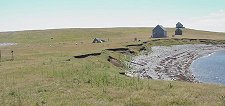This 300-acre island is located seven miles offshore, in the Town of Matinicus Isle Plantation, Knox County. The Service owns approximately 149 acres on the north end of the island, acquired in parcels between May 1994 and August 1996. Private landowners currently own about 120 sheep that graze the entire island.

Metinic Shoreline
Approximately 119 acres of Service-owned property is dominated by various grass and forb species and shrubs. The most common species are chickweed, sheep sorrel, raspberry, and bayberry. Fencing placed around vegetation plots indicates that grazing is significantly altering the species composition and height of the vegetation on the island. For example, Kentucky bluegrass, redtop, and sweet vernal grass are common in fenced areas, while these species are uncommon in grazed areas. Another 30 acres of Service-owned land in the center of the island is dominated by red spruce and balsam fir.
Several hundred pairs of terns, including a small number of roseate terns, nested on Metinic Island in the 1980’s. The decline of the Metinic colony coincided with the initiation of predator control efforts on Seal Island. We believe the Metinic Island birds moved over to take advantage of the gull-free island. Arctic and common terns have continued to nest on the south end of the island on private land; however, due to the presence of nesting gulls, the colony produces very few chicks. The Service initiated a tern restoration project on the north end of the island in 1998. Decades of sheep grazing had significantly reduced the vegetation, limiting available nesting habitat for the terns. A five-acre “peninsula” was fenced to allow the vegetation to recover and provide some shelter for the terns. Gull harassment and nest removal are utilized on the northern peninsula of the island in an effort to minimize predation on the terns.
Although terns landed among the decoys and sound system, no nesting occurred within the fenced area during the first year of the social attraction efforts. However, in 1999, one pair of common terns and two pairs of Arctic terns nested adjacent to the decoy area. Later in the season, an additional nine pairs of terns nested near the decoy area. The colony has continued to grow and in 2002, 139 pairs of common tern and 112 pairs of Arctic tern nested on the north end of the island. In addition, 15 pairs of terns nested on private land on the southern end of the island. Unfortunately, we believe gull predation continues to significantly limit the productivity of the birds nesting at the southern end of the island. Black guillemot, common eider, herring gull, great black-backed gull nest on Metinic Island. Leach’s storm-petrel also nests on the island, but because of their nocturnal nature, we do not have an accurate count on this island. Table 3-18 presents nesting seabirds known on the island.
Biological technicians are hired seasonally to work on the tern restoration program. The interns census terns, control predators, conduct food habit and productivity studies, and monitor vegetation response to grazing.
The refuge portion of Metinic Island is closed to public use during the seabird nesting season: April 1 to August 31. Informational signs alerting visitors to this closure are in place.
